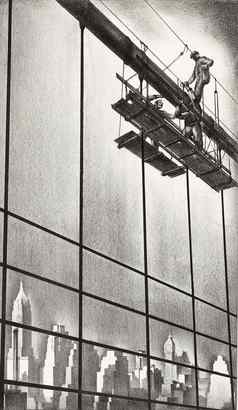Packing artwork properly is essential to preventing it from water, moisture, mold, abrasion, and overall damage to the work. You may determine the correct packing method based on where and how the work will be transported and how often the package will be opened in transit. If you have any hesitations with packing the work, hire a professional art handler to safely pack and crate the work for you.
If you decide to pack work on your own, here are some guidelines:
• cover the artwork with a soft, acid-free material, such as glassine
• wrap the work in bubble wrap or foam padding (make sure that the corners of the artwork or frame are protected with extra padding)
• secure the bubble wrap with packing tape
• find a box that is the correct size, shape and strength to hold the work
• pad the bottom of the box with packing peanuts, place the artwork inside and add more packing peanuts to fill the box
• secure the box with packing tape
• label the box "Fragile"
When packing works on paper:
• separate each sheet of paper and wrap it entirely in glassine
• secure glassine with archival tape (be careful not to get tape on the artwork)
• place two or three layers of cardboard on both sides of the artwork to prevent any sort of bending
• tape around the outside of the cardboard pieces so they stay together
To prevent works on paper from moving around within the cardboard, you can make glassine "triangles":
• fold a sheet of paper into a triangle that has one open end
• place a triangle on all four ends of the print or drawing
• tape only the triangles to the cardboard
• leave a lip of tape on the triangles, so they are easier to remove
• place each triangle on an edge of the artwork, then tape each triangle to the cardboard
• place the taped up cardboard between two pieces of corrugated cardboard
• tape all sides securely
• pack it into a mirror pack or cardboard box to prevent any type of bending during transit
At times photographs can be rolled, wrapped in glassine and bubble wrap, and placed in a tube. However, it is best to ship all works on paper or prints flat. Rolling them can cause creases and irreversible damage.
Crating is recommended for all long distance travel or for transporting fragile or vulnerable artworks. An art handler or art shipping company can provide an estimate and suggest the best crating method based on transit details. Crates should be constructed to support the work, protect the artwork from impact, maintain a sealed environment, protect against water and sometimes provide handles for moving.
 Bose Krishnamachari, a self proclaimed "artoholic," was born in India in 1963. His work (see image, left) has been included in various international solo and group exhibitions. He is also praised for his curatorial skills and possesses an impressive personal art collection. In a recent interview, Krishnamachari discusses collecting art and what his collection means to him.
Bose Krishnamachari, a self proclaimed "artoholic," was born in India in 1963. His work (see image, left) has been included in various international solo and group exhibitions. He is also praised for his curatorial skills and possesses an impressive personal art collection. In a recent interview, Krishnamachari discusses collecting art and what his collection means to him.




























